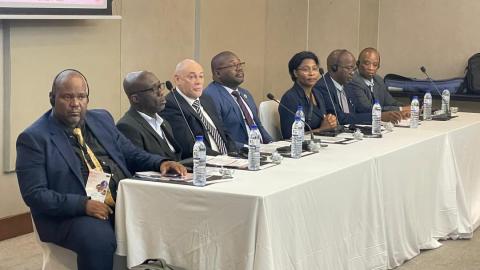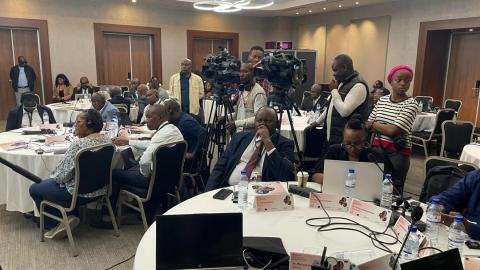
SADC Unites to End Peste des Petits Ruminants (PPR) by 2030: A Roadmap for Regional Livestock Resilience

Maputo, Mozambique 7 to 9 October 2025 ,the 4th Peste des Petits Ruminants (PPR) Regional Roadmap Meeting for the Southern African Development Community (SADC) brought together policymakers, veterinary leaders, scientists, and development partners in Maputo to reaffirm regional solidarity and chart the path toward the eradication of PPR by 2030.
Jointly organised by the WOAH Sub-Regional Representation for Southern Africa, the SADC Secretariat, the Food and Agriculture Organization of the United Nations (FAO), and the African Union-Interafrican Bureau for Animal Resources (AU-IBAR) with funding support from the European Union (EU) the meeting marked a decisive step in advancing coordinated regional action under the PPR Global Eradication Programme (GEP II & III).
The main objective of this meeting is to strengthen coordination, foster collaboration, and define a clear strategic roadmap to enhance communication visibility, and partnership outcomes within the ongoing programme. Participants collectively reviewed progress, identified key challenges, and agreed on actionable priorities to ensure alignment with regional, continental and global goals and donor expectations on the eradication of PPR.

While six SADC Member States are officially recognised by WOAH as PPR-free, and one has a PPR-free zone, several others remain at risk particularly in northern and central corridors bordering endemic regions. Coordinated surveillance, vaccination, and prevention strategies are therefore essential to protect PPR-free areas and secure livelihoods.
PPR remains one of the most devastating transboundary animal diseases, severely impacting the livelihoods of smallholder farmers who rely on sheep and goats for food security and income. Although six SADC Member States are officially PPR-free, and one maintains a PPR-free zone, several others remain at risk particularly in areas bordering endemic regions.
Opening the meeting, representatives from WOAH, FAO, and the SADC Secretariat emphasised that PPR eradication is not merely a veterinary objective, but a cornerstone for rural prosperity, trade resilience, and sustainable food systems. The gathering underscored that success depends on both technical excellence and political will.
The three-day meeting reviewed implementation of the recommendations from the previous roadmap meeting in Gaborone (2022), assessed each country’s progress using the Progressive Stepwise Approach, and updated the regional epidemiological status.
Participants also examined the alignment of national strategies with the PPR Global Eradication Programme (GEP II & III) the global blueprint for achieving zero PPR by 2030 and discussed how to enhance coordination, financing, and monitoring of eradication efforts across the region.

A high-level panel explored the technical, operational, and financial pathways to achieve eradication. Experts from across the region including specialists in disease control, emergency preparedness, cross-border harmonisation, stakeholder engagement, and financing identified five urgent priorities:
- Accelerate vaccination and surveillance in infected and high-risk countries through risk-based approaches,
- Strengthen emergency preparedness through updated contingency plans and simulation exercises,
- Harmonise cross-border interventions with synchronised vaccination campaigns and shared epidemiological data,
- Elevate advocacy and political visibility, framing PPR as a livelihood and food security emergency,
- Mobilise sustainable financing, leveraging public-private partnerships (PPPs) and innovative funding models.
The panel concluded that regional solidarity, community participation, and predictable funding remain the foundation for achieving the 2030 goal.
The participants adopted several forward-looking recommendations aimed at protecting PPR-free areas and accelerating eradication in affected zones:
1.Operationalisation of a Regional Buffer Zone
Member States agreed to formalise a PPR buffer zone across Tanzania, the Democratic Republic of the Congo, and Angola, should be validated through the SADC Livestock Technical Committee (LTC). This zone will act as a strategic shield, reinforced by harmonised vaccination, coordinated surveillance, and rapid data exchange.
2. Enhanced Regional Cooperation
Delegates endorsed the development of synchronised vaccination calendars, harmonised surveillance protocols, and cross-border coordination frameworks supported by risk mapping.
3.Advocacy and Resource Mobilisation
PPR was positioned as a livelihood and economic security emergency, with a strong call to integrate eradication measures into national development frameworks and emergency funding mechanisms.
4.Capacity Building and Laboratory Strengthening
Continuous training, inter-laboratory proficiency testing, and investment in diagnostic infrastructure were prioritised to sustain high-quality surveillance and response systems.
5.Public-Private Partnership (PPP) Engagement
Member States committed to promoting PPP models that involve private veterinarians and pharmaceutical actors in vaccine delivery, outreach, and farmer sensitisation.
Together with SADC Member States and GF-TADs Africa partners, participants agreed to operationalize regional protection zones along priority corridors under EU-funded support. The roadmap establishes a 90-day action window for immediate implementation, including:
- Finalising corridor maps and sentinel sites for surveillance;
- Submitting the technical note to SADC organs for endorsement; and
- Launching cross-border vaccination calendars with defined accountability mechanisms.

These immediate measures will strengthen protection corridors, harmonise national responses, and sustain the region’s momentum toward full eradication.
In closing, a representative of the SADC Secretariat reminded participants that:“The eradication of PPR is not just a technical mission it is a collective responsibility to protect livelihoods, secure regional trade, and uplift millions of rural families. The time to act together is now.”
The EU, WOAH, FAO, and AU-IBAR reaffirmed their continued partnership with SADC Member States, pledging ongoing technical support, coordination, and advocacy to transform the Maputo commitments into tangible outcomes.
To conclude, the Maputo PPR Roadmap represents a milestone in the region’s collective journey toward a PPR-free Southern Africa by 2030. By uniting under one shared vision powered by EU funding and regional leadership, SADC is demonstrating that PPR eradication is achievable, sustainable, and transformative for rural economies across the continent.
